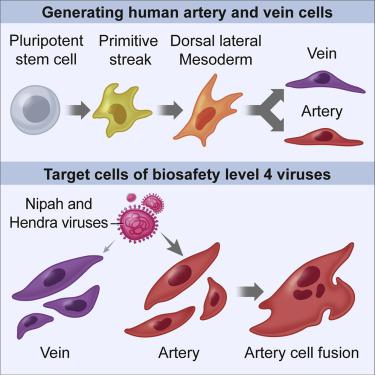Cell ( IF 45.5 ) Pub Date : 2022-06-22 , DOI: 10.1016/j.cell.2022.05.024 Lay Teng Ang 1 , Alana T Nguyen 2 , Kevin J Liu 1 , Angela Chen 2 , Xiaochen Xiong 2 , Matthew Curtis 3 , Renata M Martin 4 , Brian C Raftry 5 , Chun Yi Ng 6 , Uwe Vogel 7 , Angelika Lander 7 , Benjamin J Lesch 4 , Jonas L Fowler 2 , Alyssa R Holman 2 , Timothy Chai 2 , Siva Vijayakumar 2 , Fabian P Suchy 8 , Toshinobu Nishimura 8 , Joydeep Bhadury 8 , Matthew H Porteus 4 , Hiromitsu Nakauchi 8 , Christine Cheung 9 , Steven C George 3 , Kristy Red-Horse 5 , Joseph B Prescott 7 , Kyle M Loh 2

|
Stem cell research endeavors to generate specific subtypes of classically defined “cell types.” Here, we generate >90% pure human artery or vein endothelial cells from pluripotent stem cells within 3–4 days. We specified artery cells by inhibiting vein-specifying signals and vice versa. These cells modeled viral infection of human vasculature by Nipah and Hendra viruses, which are extraordinarily deadly (∼57%–59% fatality rate) and require biosafety-level-4 containment. Generating pure populations of artery and vein cells highlighted that Nipah and Hendra viruses preferentially infected arteries; arteries expressed higher levels of their viral-entry receptor. Virally infected artery cells fused into syncytia containing up to 23 nuclei, which rapidly died. Despite infecting arteries and occupying ∼6%–17% of their transcriptome, Nipah and Hendra largely eluded innate immune detection, minimally eliciting interferon signaling. We thus efficiently generate artery and vein cells, introduce stem-cell-based toolkits for biosafety-level-4 virology, and explore the arterial tropism and cellular effects of Nipah and Hendra viruses.
中文翻译:

从多能干细胞生成人类动脉和静脉细胞凸显了尼帕病毒和亨德拉病毒的动脉趋向性
干细胞研究致力于产生经典定义的“细胞类型”的特定亚型。在这里,我们在 3-4 天内从多能干细胞中产生了 90% 以上的纯人类动脉或静脉内皮细胞。我们通过抑制静脉特异性信号来指定动脉细胞,反之亦然。这些细胞模拟了尼帕病毒和亨德拉病毒对人类脉管系统的病毒感染,这些病毒极其致命(~57%–59% 的死亡率),需要生物安全 4 级遏制。生成纯动脉和静脉细胞群体强调尼帕病毒和亨德拉病毒优先感染动脉;动脉表达更高水平的病毒进入受体。受病毒感染的动脉细胞融合成含有多达 23 个细胞核的合胞体,并迅速死亡。尽管感染动脉并占据其转录组的~6%–17%,Nipah 和 Hendra 在很大程度上避开了先天免疫检测,最低程度地引发了干扰素信号传导。因此,我们有效地生成了动脉和静脉细胞,引入了基于干细胞的生物安全4级病毒学工具包,并探索了尼帕病毒和亨德拉病毒的动脉趋向性和细胞效应。









































 京公网安备 11010802027423号
京公网安备 11010802027423号